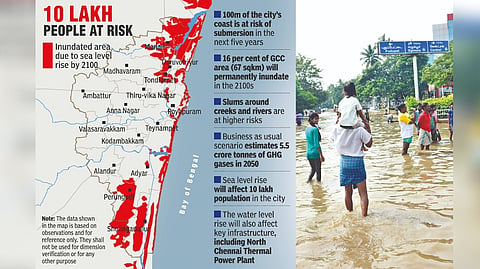

CHENNAI: Nearly a sixth of Chennai will be permanently inundated by 2100 due to sea level rise induced by climate change, which would affect at least a million people, warned a draft report released by the Greater Chennai Corporation.
More immediately, the sea level rise is likely to submerge about 100 metres of the coastal area in the city in the next five years, it added.
According to the report that the Corporation prepared along with C40 Cities and Urban Management Centre, around 67 sqkm (16 per cent of Chennai) will be permanently inundated, affecting around 10 lakh population.
About 215 slums, which is 17 per cent of the slums in the city, may get affected, it said, adding that high-density slums located around creeks and rivers are at a higher risk.
Also, 7,500 Tamil Nadu Urban Habitat Development Board (erstwhile Slum Clearance Board) tenements may also face inundation.
The report added that 100 metres of the coastal area at a risk of submersion as a result of sea level rise of seven cm in the next five years.
The water level rise will also affect key infrastructure, including North Chennai Thermal Power Plant, which will require replacement, 18 Metro Rail stations, 28 MTC bus stops, and other infrastructure by the year 2100.
Emission of greenhouse gases (GHG), the major cause of climate change and sea level rise, is higher from residential buildings that contribute to 31% of the total emission in the city.
In contrast, commercial and institutional buildings emit 26 per cent and private transportation 14 per cent of the GHG gases, respectively.
Due to urban heat island effect, the Airport area recorded an average temperature of 43.3 degree Celsius in 2021, while it was only 23 degree Celsius in Guindy National Park.
Climate change will also result in reduction in rainfall, drinking water scarcity and shrinking of waterbodies, the report cautions.
In 2018, over 1.43 crore tonnes of GHG emitted in the city, which is estimated to go up to 5.5 crore tonnes in 2050 under ‘business as usual’ scenario.
The target is to achieve carbon neutrality (zero emission). The existing and planned initiatives is likely to reduce it to more than 3.5 tonnes of GHG in 2050.
Study moots action plan to reduce effect
The report proposes decarbonising the electric grid and increasing usage of renewable energy, promoting energy efficient buildings, remediation of existing dumpsite while ensuring no waste is being dumped in the open, and managing urban floods and water scarcity.
To manage floods and conserve natural water ecosystems, the report recommends developing sponge parks in OSR lands, rain gardens, biodiversity parks, urban forests and others, preserving natural drains to maintain natural flow of water covering the entire catchment area. It proposes to shift 15 per cent of the bus fleet to electric by 2030 and 100 per cent by 2050 and also ensure that 80 per cent trips are by walking, cycling or public transit.
For institutional strengthening to implement climate action plans, the report recommends the formation of a State level council led by the CM and also a Corporation level council, with participation of area sabhas and ward committees.
City residents can access the full draft report on GCC’s site, and send comments and suggestions to chennaiclimateactionplan@gmail.com before September 26, officials said.
Visit news.dtnext.in to explore our interactive epaper!
Download the DT Next app for more exciting features!
Click here for iOS
Click here for Android